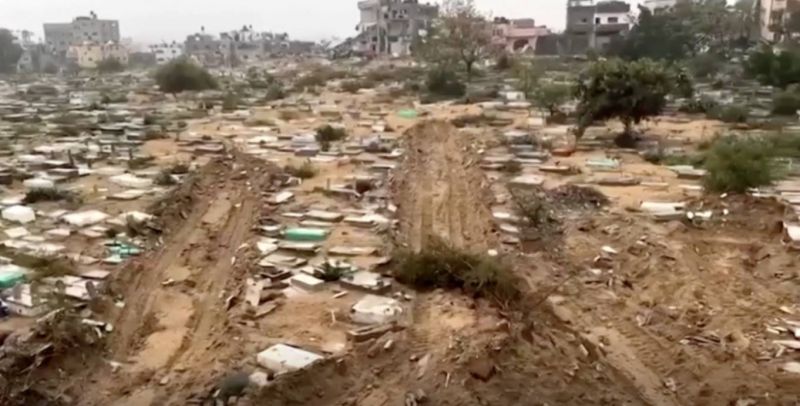
Israeli bulldozers destroyed the al-Faluja cemetery in the town of Jabalyia. (Credit: Screenshot of video footage broadcast by Reuters on Dec. 13)
As if taking the lives of nearly 19,000 people was not enough, the Israeli army attacked those who were already resting in peace. In recent weeks, Palestinian burial grounds were desecrated amid Israel’s ground incursion into the Gaza Strip which commenced Oct. 21.
Analyses of satellite imagery and video footage published by the New York Times revealed that Israeli forces partially destroyed at least six cemeteries in northern Gaza since the start of their ground offensive in the enclave, mostly in recent weeks.
The destruction of these civilian sites could be tantamount to a war crime if Israel fails to prove that it committed the acts for a compelling military need.
In Gaza City’s Shajaiye neighborhood, satellite images taken Dec. 10 identified armored vehicles and earthen fortifications at the Tunisian cemetery, where tombstones had stood just days before. Israel has not yet provided a reason as to why a military position was improvised on a civilian and religious site.
The Israeli army had set up other temporary positions, which The New York Times described as “protective,” throughout the enclave, to facilitate the advance of troops.
One kilometer north-west of the strip, the small Ben Marwan cemetery was partially razed after the Israeli army arrived in the area, according to Jake Godin, a Bellingcat Series reporter who analyzed satellite videos and images of the destruction of north Gaza cemeteries in recent weeks.
The same observation was made in another town. In Jabaliya, the al-Faluga cemetery was targeted by Israeli bulldozers, as depicted in video footage broadcast on Dec. 13 by Reuters. The footage showed shattered tombstones, upturned earth, uprooted vegetation and what appeared to be body bags strewn across the ground.
While most of the images date back to operations at the beginning of the month, a cemetery in the northeast Gaza town of Beit Hanoun, near the border with Israel, was largely destroyed in the second half of November, reported Godin.
This would have been during the week-long truce for the hostage-prisoner exchanges. The New York Times also identified other cemeteries that were trashed in Gaza City’s Sheikh Ijlin neighborhood, in Beit Lahia and in a locality in the far north of Gaza.
The Israeli army refused to respond to The New York Times’ inquiries about why it razed the cemetery in Shajaiye and whether precautions had been taken to protect religious sites during its ground offensive.
Amid the destruction, Euro-Med Human Rights Monitor said on Thursday that dead bodies, believed to be those of Palestinian activists, had even been “stolen” by Israeli forces.
The issue of sparing religious sites, based on being civilian or even protected areas, has arisen beyond Gaza’s war zone in the other theaters of Israeli operations, like the West Bank.
On Thursday, Israeli soldiers entered the Jenin mosque during another deadly raid on the town. Filmed by his peers, a soldier stood on the minbar, a platform reserved for preachers, and sang Hanukkah songs into the mosque’s loudspeakers. The Israeli army condemned the act and said it would take disciplinary action against the soldiers involved.
In 2021, the construction of a park near Jerusalem’s Bab al-Asbat Cemetery sparked anger when workers found bones, although Israeli authorities had promised not to touch the tombs.
This article was originally published in French in L'Orient-Le Jour. Translation by Joelle El Khoury.